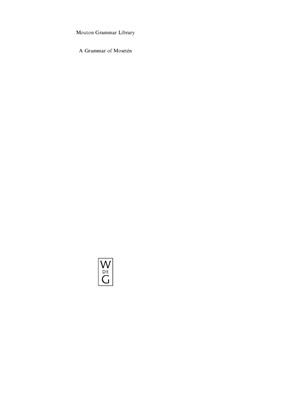Sakel, Jeanette. (2004). A grammar of Moset?n. Mouton Grammar
library,
33. ISBN 3110183404, 9783110183405. 504 pp.
The language Moset?n is spoken in Bolivia, in the easte foothills of the Andes. Together with Chimane (Tsimane'), it forms the language family Mosetenan. This language family has not yet been proved to be related to other languages. The task of this book is to provide a grammatical description of Moset?n in the form of a descriptive reference grammar. It is intended to be comprehensive and aimed at linguists from all backgrounds. Because of this, I have tried not to use specific terminology, as far as that was possible. The grammar is divided into a short chapter on phonology (2) and six chapters on the morphology: morphological processes (3 ) the nominal system (4 ), pronouns and reference (5 ), adjectives and adverbs (6 ), quantification (7 ) and the verbal system (8 ). These chapters are followed by voice (g. ), negation (10 ) and modality and discourse markers (11 ). Finally, there are two syntactically oriented chapters on clause types (12 ) and clause combinations (13 ). In the appendix, I provide texts in the language, as well as a list of grammatical markers (affixes, clitics and particles).
33. ISBN 3110183404, 9783110183405. 504 pp.
The language Moset?n is spoken in Bolivia, in the easte foothills of the Andes. Together with Chimane (Tsimane'), it forms the language family Mosetenan. This language family has not yet been proved to be related to other languages. The task of this book is to provide a grammatical description of Moset?n in the form of a descriptive reference grammar. It is intended to be comprehensive and aimed at linguists from all backgrounds. Because of this, I have tried not to use specific terminology, as far as that was possible. The grammar is divided into a short chapter on phonology (2) and six chapters on the morphology: morphological processes (3 ) the nominal system (4 ), pronouns and reference (5 ), adjectives and adverbs (6 ), quantification (7 ) and the verbal system (8 ). These chapters are followed by voice (g. ), negation (10 ) and modality and discourse markers (11 ). Finally, there are two syntactically oriented chapters on clause types (12 ) and clause combinations (13 ). In the appendix, I provide texts in the language, as well as a list of grammatical markers (affixes, clitics and particles).

